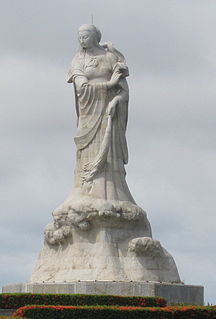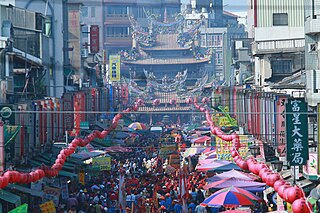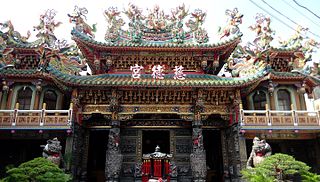
Mazu is a Chinese sea goddess also known by several other names and titles. She is the deified form of the purported historical Lin Mo or Lin Moniang, a Fujianese shamaness whose life span is traditionally dated from 960 to 987. Revered after her death as a tutelary deity of seafarers, including fishermen and sailors, her worship spread throughout China's coastal regions and overseas Chinese communities throughout Southeast Asia. She was thought to roam the seas, protecting her believers through miraculous interventions. She is now generally regarded by her believers as a powerful and benevolent Queen of Heaven. Mazuism is popular in Taiwan as large numbers of early immigrants to Taiwan were Fujianese; her temple festival is a major event in the country, with the largest celebrations around her temples at Dajia and Beigang.

Taoyuan is a special municipality in northwestern Taiwan, neighboring New Taipei City, Hsinchu County, and Yilan County. Taoyuan District is the seat of the municipal government and which, along with Zhongli District, forms a large metropolitan area. Taoyuan developed from a satellite city of Taipei metropolitan area to become the fourth-largest metropolitan area, and fifth-largest populated city in Taiwan. Since commuting to the Taipei metropolitan area is easy, Taoyuan has seen the fastest population growth of all cities in Taiwan.

Xinwu or Sinwu District is a rural, coastal district in Taoyuan City, Taiwan.
Like many of Taiwan's older cities, Taichung has a large number of old temples and shrines that have historical value and are typical of the eras in which they were built. They include family and public Taoist and Buddhist temples, a Confucian temple, and even a Japanese Shinto Shrine.

The Thien Hau Temple, officially the Ba Thien Hau Pagoda, is a Chinese-style temple of the Chinese sea goddess Mazu on Nguyễn Trãi Street in the Cho Lon ("Chinatown") of District 5 in Ho Chi Minh City, Vietnam.

Guwenhua Jie, Tianjin's Ancient Culture Street, is a pedestrian pathway complex dotted with temple gates and kiosks on the west bank of the Hai River in Tianjin, China. The Nankai District area is classified as a AAAAA scenic area by the China National Tourism Administration.

The Chaotian or Chaotien Temple, officially the Chao-Tian Temple, is a temple to the Chinese sea-goddess Mazu in Beigang Township, Yunlin County, Taiwan. Constructed in 1700, it became one of the most important Mazu temples in Taiwan and is known for its extravagant temple architecture. It is visited by more than a million pilgrims every year.

The Ma-Cho, Mazu or Ma Cho Temple is a Taoist temple to the Chinese sea-goddess Mazu located on Quezon Avenue in Barangay II, San Fernando, La Union in the Philippines. It was built in 1977 by a group of Filipino-Chinese devotees under the leadership of Dy Keh Hio and with the support of former Tourism Secretary Jose D. Aspiras.

The Cide Palace or Temple on Dianziding Street, also known as the Dianziding, Liujia, Mazu, or Tianhou Temple, is a temple northwest of Lotus Lake in Zuoying District, Kaohsiung, Taiwan. In Chinese, it is formally distinguished by its address to differentiate it from the separate Cide Palace north of Kaohsiung's airport.
The Luerhmen History and Culture Museum is a historical and cultural complex in Annan District, Tainan, Taiwan.

The Dajia Jenn Lann Temple, also known as the Zhenlan or Mazu Temple, is a temple to the Chinese sea goddess Mazu, the deified form of the medieval Fujianese shamaness Lin Moniang, located in the Dajia District of Taichung, Taiwan.

The East Zhejiang Maritime Affairs/Folk Custom Museum is a museum located in Yinzhou District in Ningbo, Zhejiang, China. It is located in the Qing'an Guildhall, a reconstructed complex which once housed a temple to the sea-goddess Mazu. Originally built in 1191, the complex was destroyed and rebuilt several times. After its mid-19th century restoration by Ningbo's guild of Fujianese merchants, it was acclaimed as one of the most beautiful temples in China and was used by the merchants as their guildhall. It was destroyed in 1949 as the Communists were fighting the Chinese Civil War, and suffered further harm during the Cultural Revolution, but was repaired from 1997–2001. It reopened in June 2001 as a museum dedicated to eastern Zhejiang's maritime history and local arts and crafts.

The Tianfei Palace, officially the Mazu Cultural Palace and also known as the Tianhou Palace, is a restored temple of the Chinese sea-goddess Mazu, the deified form of the medieval Fujianese shamaness Lin Moniang, located in Fangta Park in Songjiang, Shanghai, in eastern China. Officially classified as a museum, the Tianfei Palace conducts Mazuist rites twice a year, on the traditional anniversaries of Lin Moniang's birth and death. It is also used as the site for an annual commemoration of Songjiang's city god Li Daiwen.

The Grand Matsu Temple, also known as the Datianhou or Great Queen of Heaven Temple, is a temple to the Chinese sea goddess Mazu, the deified form of the medieval Fujianese shamaness Lin Moniang, located in the West Central District of Tainan on Taiwan.

The Tianhou Temple, also known as the Kaitai Tianhou or Mazu Temple, is a temple to the Chinese sea goddess Mazu, the deified form of the medieval Fujianese shamaness Lin Moniang, located in the Anping District of Tainan on Taiwan.

The Lugang Mazu Temple, also known as the Lukang TianhouTemple, is a Chinese temple dedicated to the Chinese sea goddess Mazu, the deified form of the medieval Fujianese shamaness Lin Moniang, located at 430 Zhongshan Road in Lukang Township, Changhua County, Taiwan. It is one of the island's most famous and popular Mazu temples.

The Mazu Temple in Magong is a temple to the Chinese sea goddess Mazu, the deified form of the medieval Fujianese shamaness Lin Moniang. It is located at 1 Zhengyi Street (正義街1號), Magong City, Penghu, Taiwan. It is usually accounted the oldest Mazu temple in Taiwan and, despite the present differences in characters, is the namesake of the surrounding city of Magong. It is open from 7:00 am to 5:30 pm daily.
















